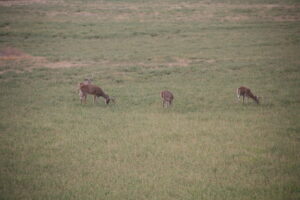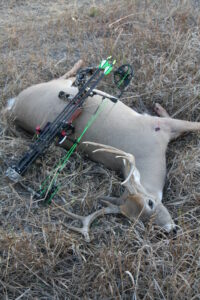By Bernie Barringer
Many a heart has been broken by a whitetail buck during the earliest parts of deer season. I am sure you can relate. You watched him all summer, drooling on your spotting scope. He came out into the field at a predictable time in a predictable place several times a week. Could this really be the year you score on a great buck in the first few days of the season? What could possibly go wrong?
Several things can go wrong and usually do. This scenario seems to hold so much promise, yet the numbers of hunters who have actually pulled it off are remarkably low. There are three primary reasons why the wheels come off your plans. First of all, many hunters forget to take into account the changing daylight hours. You see the evening sun shining on those huge velvet antlers in early August at 8:00 p.m. but by the time the archery season opens, it’s dark at 8:00. The bucks haven’t changed their stomach-driven timing, but the shorter daylight hours have caught up to him. He’s coming out at the same time, but you can no longer see him.
Secondly, the buck’s hormones are beginning to work against you. As the velvet comes off, the bucks begin to change their demeanor. They no longer tolerate the presence of small bucks at their side, and they are reluctant to wade right out into the open like they did during the lazy days of summer. They hang back in the trees and survey the field, watching the body language of the does and smaller bucks, biding their time until they feel safe. They are paying more attention to the wind than they were a month ago. They rarely travel far without the safety of a breeze on the side of their face. The good news is these bucks start using predictable staging areas between their bedding areas and the fields. This is where we will focus our efforts, but we need to be careful not to ruin it on number three.
The third thing that goes wrong for many hunters is something over which we have more control. Many hunters blow it when they launch their first early-season attack. They move in too soon, or they screw it up when they put up a treestand on the edge of the field where the buck has been coming out, leaving too much scent and too much sign in the form of cut branches, smashed underbrush and obvious disturbances. Or they just can’t wait for the perfect wind. They let their anticipation overtake their patience and try to cheat the wind. You may only get one chance at this and you better make sure you wait until it is right.
In most cases, if you put your stand right on the edge of the field, which seems like the most logical place, you have just reduced your chances significantly. Remember how the buck is hanging back and looking for anything wrong before heading out into the field? You just put yourself right where he is looking. You need to move back into the staging area.
These mature bucks hang back 30-60 yards from the field edge and patiently observe. Sometimes slowly browsing around, sometimes making scrapes and rubs, and sometimes just standing and staring intently for painfully long periods. This is where you need to set up, not right on the edge of the field.
It helps to know the location of the bedding area and the general lay of the land between that bedding area and the field where you have observed these deer. Bedding areas can change based on weather and human disturbance, but there are specific areas where they tend to bed year after year. The areas they choose to travel between the bedding area and the food will allow them good concealment cover and the opportunity to quarter the wind whenever possible.
When they arrive at the edge of the field, the does and young bucks often move right out into the open while the mature bucks hang back. Interestingly, does and small bucks usually trot out a few yards from the edge of the brush before they begin to feed. When the older bucks finally do enter the field, they often stay right on the edge, alternating between observing and nibbling, before working well out into the open. Once you have a general idea of the direction the bucks are approaching the field, it’s time to figure out exactly where they are staging. Put your system into motion.
Having a system is important because it allows you to set up quickly and efficiently with a minimum of disturbance. There are cases where the staging areas will be the same year after year, but things like crop rotations, wind directions, availability of water, hunting pressure and even obscure activities like firewood cutting will change the deer’s habits from year to year.
The first thing I like to do is move in carefully during the late morning and set up a few trail cameras. Late morning works well because the dew is off the plants, yet it gives your scent some time to age before the deer show up in the afternoon. Believe me a buck knows the difference between scent that is eight hours old and scent that is three hours old, and he will react accordingly.
When I cautiously penetrate the area, I am looking not just for the trails deer are using to approach the field, but specifically for fresh rubs. Scrapes are important but secondary sign; rubs are more reliable indicators of where the bucks are staging. Rubs found right on the man trails are most often made by younger bucks; the rubs you find in the thick stuff off to the side of the main trails are the ones you really want to see. Put a camera on these areas and then don’t go back to check them for at least a week. Always have a minimally intrusive mindset. Once the cameras have allowed you to inventory the bucks and learn their patterns, it’s time to get a stand in place.
When it comes to putting in the treestand, having a system means you get in, get set up and get out. This is best accomplished with a partner. That way you can carry everything to the site in one trip and each of you has a list of tasks. No wandering around looking for the right tree. Know in advance what wind direction you are going to hunt the stand from and stick to it. Once again, this is best done in the late morning.
I start cutting shooting lanes while my buddy starts putting up the stand. A back pack has everything we need to put an entire set in place in short order, right down to the bow hanger and the safety harness. We can get in and out in 15 minutes or less. When you set up your stand, take the cameras out with you. Hopefully, you are going to make just one more trip in there; to kill the buck.
Once the setup is in place and the season opens, the wait can get tough. You know the bucks are using the area; in your mind you can just see them milling around your treestand during those last 20 minutes of daylight. Resolve to wait until conditions are perfect and then go get them. Moving on a buck too soon has saved the lives of a lot of mature deer over the years. Don’t be the one responsible for saving the life of the buck of your dreams.
The bucks you have been watching casually munching on alfalfa and soybeans through the late summer are certainly killable. There is a short window of opportunity to get it done. You will need to find their staging area, then work your system and have patience. Taking one for a pickup ride is not the slam dunk it may first appear to be, but it can be done.
